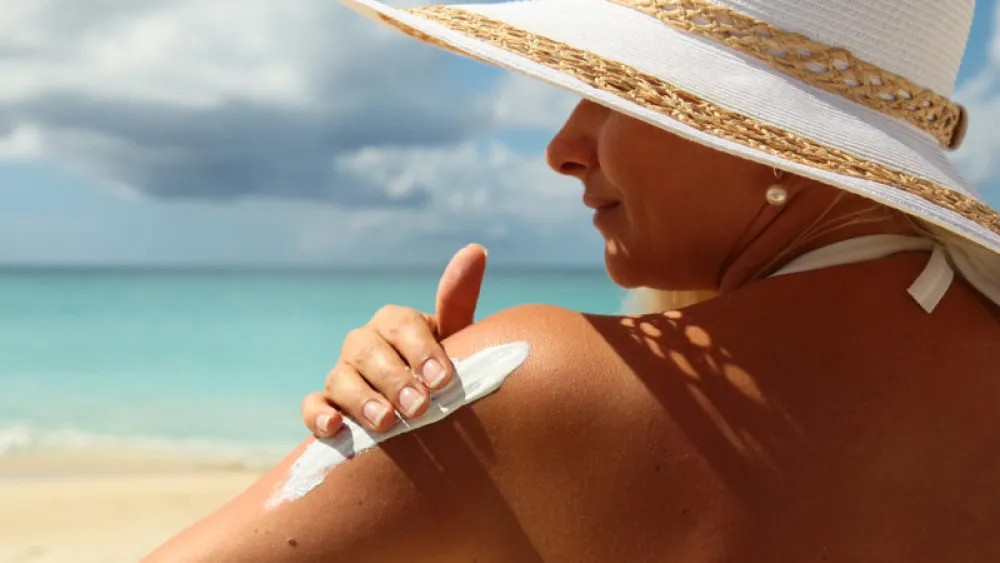




Today's Medicine
Test Your Sunscreen IQ
Published: June 8, 2022

Now that warm weather is upon us, it’s time once again to think about how much time we are spending in the sun and make sure we’re taking the proper precautions. Sunscreen is an essential part of staying safe.
So how sun smart are you?
Let’s Put Your Sun Protection IQ to the Test
TRUE OR FALSE: The sun’s rays are always bad for you.
TRUE AND FALSE. (Yes, that was a trick question!) We all know that too much of a good thing can be a bad thing. That’s why we have to protect ourselves. So let’s deliver the bad news first.
The sun delivers a harmful spectrum of ultraviolet light called UVA and UVB rays. The easy way to remember that is UVB/burning, and UVA/aging. Not only are we at risk of getting a sunburn when we're in the sun, but repeated exposure to the sun's rays will also lead to aging.
So too much sun will obviously burn your skin. Stay out too long and those burns can be quite serious. Too much sun exposure can lead to permanent skin damage and put you on a path to deadly skin cancers.
But believe it or not, there are rays from the sun that are actually good for us.
We get vitamin D from the sun's rays. Fifteen minutes of sun exposure allows you to absorb adequate amounts of vitamin D. It's very hard to consume enough vitamin D in our diet to adequately maintain our levels.
Short durations in the sun can help boost levels of vitamin D. Just remember, any longer than 15 minutes and you can risk damaging your skin.
TRUE OR FALSE: So if some sun is good for me, I should wait to put on sunscreen.
FALSE. It takes a standard sunscreen 15 minutes to absorb into your skin and begin protecting you from the sun’s harmful rays. That’s why it’s important to apply before you go outdoors if you plan on being out for an extended period of time. That being said, some thought also needs to go into what you wear.
First and foremost, your best protection from the sun is going to be clothing. If your skin is covered, it's protected. Think hats, scarves, long sleeves and something covering your neck.
TRUE OR FALSE: All sunscreens are the same.
FALSE. There are two main types of sunscreen – chemical blockers and physical blockers.
Chemical blockers, which are the typical brands you find on store shelves, work by converting the sun's rays to a different form of energy that won’t cause burning and often protects against the narrow spectrum of the rays that cause aging. Instead, the sun’s rays go into the skin as a harmless form of energy, as opposed to UVA and UVB rays. Sometimes you can notice that it's working when you apply it. You almost feel a warming sensation because it causes a thermal reaction as it converts to this different form of energy that your body absorbs.
Physical blockers provide a protective barrier between you and the sun. That can include clothing or even lotion sun block.
If you think of the old movies where people have the big white strip of zinc on their nose, that’s a physical blocker. They actually make it now so it absorbs much better and is what we call an "invisible zinc." Those actually work by providing a barrier. The sun's rays come down and are reflected directly off of it. So your skin does not absorb any of it.
Lotion sun blockers will include ingredients like zinc or titanium, so look for those on the label.
TRUE OR FALSE. The longer I plan to be outside, the higher SPF sunscreen I should apply.
FALSE. You really only need to apply a sunscreen containing an SPF (sun protection factor) of 30.
Sunscreens with an SPF of 30 actually block 95 to 99 percent of the sun’s harmful rays. The higher the SPF, the more they're going to charge you for really a negligible amount more of protection from the sun's rays. There’s not a major difference.
TRUE OR FALSE. Sunscreen lotions are better than sprays.
HMMMM. … DEPENDS ON WHO YOU ASK AND HOW YOU APPLY! Sunscreen sprays are generally effective at providing adequate skin protection. However, the problem comes in how it is applied.
Sunscreen should be applied liberally and equally over the skin. The issues stem from missed areas or areas that don’t receive enough coverage. Sprays, however, are lightweight and easier to use and reapply as needed.
Lotions can be gloppy and greasy, and difficult to apply. However, they can provide a deeper coverage since you have to actually rub it in. Lotions also have a moisturizing effect and are creamier.
Dermatologists say no matter what type of sunscreen you use, use the proper SPF and give it time to soak in before going into the sun. Also, be sure to reapply every two hours (or more often if you get wet or very sweaty) for maximum protection.
Need Help When It Comes to Sun Protection?
If you have questions about how to best protect yourself from the sun, talk with your Methodist Physicians Clinic primary care provider or dermatologist.


